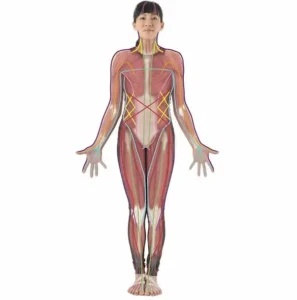If you’ve ever felt tight, tired, or just “off” without a clear reason, there’s a good chance your fascia might be the culprit. Believe it or not, your fascia — the body’s internal webbing — can get clogged and sluggish, creating a ripple effect that slows everything down: movement, circulation, energy, even mood.

What Exactly Is Fascia?
Fascia is the connective tissue that surrounds and supports every part of your body — muscles, bones, nerves, and organs. Think of it as a continuous, glistening web that holds you together and keeps everything in place.
But fascia doesn’t just provide structure; it’s also incredibly intelligent and dynamic. The unique makeup of fascia allows it to act as a communication highway and a transport system for your body’s internal currents.
Fascia: The Body’s Inner Highway
Electrical impulses, water, and healing signals all move through this one powerful system. Fascia conducts tiny electrical signals that help different areas of your body talk to each other — muscles coordinating with joints, the nervous system communicating with tissues, and healing signals reaching areas that need repair.
In addition, fascia is the pathway for interstitial fluid, the clear liquid that nourishes your cells and removes waste. This fluid flows through the tiny spaces within the fascia, delivering nutrients while carrying toxins and metabolic waste out toward the lymphatic system for elimination.
When fascia is healthy, this flow is smooth and efficient — your tissues feel supple, movement feels easy, and your body feels “in sync.”
When Fascia Gets Clogged
Problems arise when fascia loses its glide. Injuries, repetitive movements, emotional stress, dehydration, or even poor posture can cause the collagen fibers in fascia to stick together. The result? Fascia becomes tight, dehydrated, and restricted, slowing down both fluid circulation and electrical communication.
That’s when you start to feel stiffness, fatigue, or vague aches that don’t seem connected to any specific muscle. The body’s natural healing processes also slow down because nutrients and signals can’t move freely through the fascia.
Why Myofascial Release Matters
Myofascial release therapy helps restore this glide. Through slow, sustained pressure and gentle movement, this technique rehydrates and unbinds the fascia, freeing up stuck layers and allowing your body’s natural energy and fluids to move again.
At Neu Release Massage in Austin, Texas, our therapists specialize in helping clients reconnect with their bodies through targeted myofascial release work. These sessions go deeper than a typical massage — they relieve structural tension, support your nervous system, and get your fascia flowing and communicating again.
Feel Fluid, Connected, and Energized Again
Your fascia deserves attention. When it’s healthy, your whole body functions better — movement feels smoother, pain subsides, and your energy levels rise naturally.
If you’re feeling stiff, drained, or disconnected from your body, it’s time to release what’s stuck.
Ready to try the best Myofascial Release in Austin Texas?
Book a fascia focused massage at Neu Release Massage in Austin, Texas and experience how freeing your fascia can transform how you feel from the inside out.
